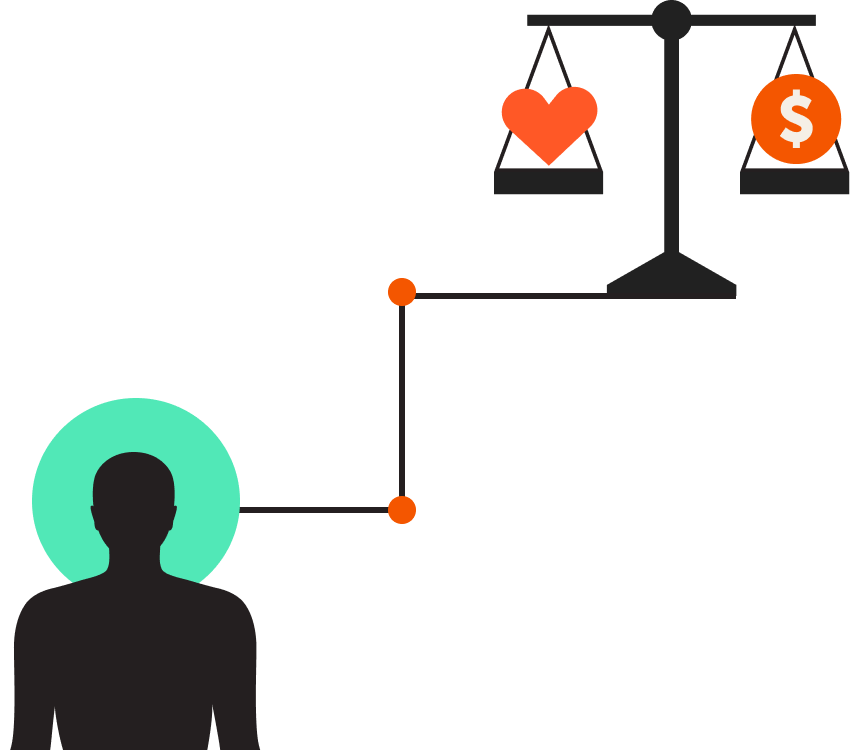Bridging the health and wealth divide
Bridging the health and wealth divide

To be healthy, wealthy, and wise.
It’s all anyone can ask for, isn’t it?
The relationship between physical wellbeing and financial security represents one of the most significant yet often overlooked influences shaping our quality of life.
These elements are intrinsically linked, creating what experts now refer to as “vitality”—a holistic state of thriving that goes beyond conventional wellness definitions to encompass both health and financial resilience.
In an endeavor to understand how financial and health outcomes are impacting consumers’ lives, choices, and overall wellbeing, Monigle has authored the Humanizing Brand Experience reports, in which we survey consumers and evaluate healthcare organizations and financial brands nationwide. We uncover insights about consumer expectations, trust, and engagement, and the intertwined future of health and wealth.
Table of contents
The health and wealth connection: A foundation for human vitality
According to Monigle’s Humanizing Brand Experience: Financial Services edition, Vol 4 report, in partnership with American Banker, only 18% of Americans rate their overall well-being as excellent, with both physical and financial health lagging at just 15%. It also shows that while people rank physical health as their top priority, followed by emotional, mental, financial, and social wellbeing, this hierarchy masks a deeper truth.
Healthcare providers and financial institutions have operated in silos, missing crucial opportunities to address these interconnected challenges. As life expectancy increases and definitions of both health and wealth evolve, it’s time for a new approach that recognizes and responds to the profound connection between financial stability and overall wellbeing.
Health and wealth’s interconnected nature, among other bidirectional forces, has given rise to the concept of vitality, which embodies an individual’s capacity to live with energy, strength, and purpose in pursuit of a fuller life.
Rather than treating health and wealth as separate domains, vitality allows us to recognize that true wellbeing encompasses not just the absence of illness or debt, but the presence of physical, emotional, and financial resilience.
How is your healthcare organization considering vitality to improve future care for consumers and close health and wealth gaps?
The numbers that demand action
The stark reality of health disparities by income tells an uncomfortable but honest story.
According to our research, those living in poverty are five times more likely to report poor health compared to higher-income individuals. The gap in life expectancy between the highest and lowest income groups spans 10-15 years – a decade or more of life determined largely by financial circumstances.
Furthermore, for those earning under $35,000 annually, the mental health toll is equally severe – they’re four times more likely to report persistent nervousness and five times more likely to experience chronic sadness.
This isn’t a new phenomenon. The Whitehall Studies of the 1960s revealed a clear inverse relationship between employment grade and mortality risk among British civil servants, even when controlling for lifestyle factors like smoking, diet, and exercise.
What’s new is our growing understanding of just how deeply these forces intertwine.
How health shapes wealth: The financial impact of wellbeing
The intersection of health and financial wellbeing runs deeper than hospital bills and insurance premiums. It’s a complex relationship that determines individual futures, family legacies, and community prosperity.
The hidden costs of poor health: Beyond medical bills
When health falters, financial stability often follows. While the immediate impact of medical expenses is staggering—with 42% of Americans struggling to pay medical bills or pay off medical debt—it’s just the first domino to fall. The cascading effects ripple through careers, savings accounts, and generations.
Lost wages from missed work, diminished earning capacity, and disrupted career trajectories create both immediate hardship and long-term financial vulnerability. It’s a sobering reality that medical debt has become the primary driver of personal bankruptcy in America, accounting for 62% of cases.
Even more concerning are the broader economic implications. Chronic conditions like diabetes, heart disease, and depression don’t just affect individual bank accounts—they reshape entire economic landscapes. These conditions drain an estimated $3.7 trillion annually from the U.S. economy through combined medical costs and productivity losses, highlighting the intertwinement between population health and economic vitality.
The mental toll: Where financial and emotional health converge
Financial stress and health concerns create a powerful feedback loop that can trap individuals in cycles of declining wellbeing. 42% of Americans report experiencing panic or anxiety attacks related to their financial situation, according to our research. This mental health burden doesn’t just cause emotional distress—it can impair judgment around crucial life decisions – especially financial ones – from daily budgeting to long-term planning.
Despite these clear connections, a troubling gap exists in support systems. While, according to Humanizing Brand Experience: Healthcare edition, 28% of consumers report delaying necessary healthcare due to financial concerns, healthcare organizations rarely initiate conversations about financial wellbeing unless they’re directly offering financial services. This silence leaves many families navigating these intertwined challenges without guidance or support.
These disparities cast long shadows. The relationship between health and wealth doesn’t end with individuals—it can echo across generations.
Childhood health and wealth barriers
Perhaps most concerning, children growing up in households burdened by medical debt face their own obstacles to financial security, with data showing they’re less likely to achieve upward mobility due to food insecurity, and negative mental health outcomes, among other drastic consequences. The long-term implications of this generational health-wealth gap are sobering, threatening to perpetuate cycles of financial instability and poor health outcomes.
A child from a low-income family is four times as likely to be in poor or fair health than their peers from high-income families. Educational opportunities – themselves often determined by family financial status – lay the groundwork for future career prospects and health literacy, while early access to proper nutrition plays a crucial role in lifelong health outcomes.
A generation at risk
The health-wealth connection reveals particularly troubling patterns across generations. Gen Z faces unprecedented challenges, with just 28% rating their financial health positively – a sharp contrast to 32% of Millennials, according to our research. This disparity isn’t just about money in the bank – it signals potential long-term health vulnerabilities that could compound over time if left unaddressed.
Gen Z and Millennials report feeling overwhelmed by financial pressures, according to the research, with many struggling to find meaning in their work or satisfaction in their lives. Career disruptions due to health issues can permanently alter earning trajectories. Chronic conditions may force dramatic adjustments to retirement plans. Access to affordable insurance often becomes more limited, creating additional financial strain.
This early exposure to financial anxiety can cast a long shadow, affecting both mental health and financial decision-making throughout adulthood.

How financial wellness impacts health outcomes
The influence of financial status on health runs deeper than just affording medical care – it drives the environmental, social, and economic conditions that create and maintain health across generations.
Social determinants of health and financial status
The impact of financial disparities manifests clearly in community infrastructure and access to critical resources. Low-income neighborhoods have 30% fewer grocery stores, directly impacting residents’ ability to maintain healthy diets. Transportation barriers affect both economic opportunity and healthcare access. Housing quality and neighborhood conditions profoundly influence physical and mental wellbeing.
Higher income levels typically correlate with reduced exposure to environmental hazards, lower crime rates, and fewer chronic stressors. Additionally, financial security enables health-promoting investments like preventive care, wellness programs, and lifestyle choices that support long-term health.
The virtuous (or vicious) cycle
The health-wealth relationship operates as a two-way street, creating either virtuous or vicious cycles. Financial stress manifests physically – disrupting sleep, exacerbating chronic conditions, and fueling anxiety and depression. Poor health, meanwhile, can devastate financial stability through reduced earning capacity, mounting medical bills, and depleted savings.
When physical and mental wellbeing are strong, individuals can focus on career advancement, maintain consistent work attendance, and make clear-headed financial decisions. This positive cycle creates opportunities for wealth building through increased earning potential, reduced medical expenses, and the capacity to invest in preventive care and wellness activities.
The stakes and the opportunity
With only 57% of U.S. adults considered financially literate, many lack the foundational knowledge to navigate this crucial intersection of their lives. And the impact extends far beyond the individual level. Research suggests inequalities in the health outcomes of the lowest-income groups versus those of the highest are costing the U.S. health system $320 billion.
According to the Humanizing Brand Experience: Financial Services edition, Vol 4 report, 85% of consumers believe improvements in their financial health would trigger moderate to life-altering positive changes across all dimensions of their lives.
For healthcare and financial institutions, this presents both an imperative and an opportunity – a chance to create meaningful change while building deeper, more trusting relationships with the communities they serve.
Innovative solutions for bridging the health-wealth gap
Humanizing Brand Experience: Healthcare edition shows that 53% of consumers now value holistic healthcare that treats the whole person – mind, body, and spirit.
This expanding recognition creates an unprecedented opportunity for healthcare and financial institutions to work together in addressing these fundamental determinants of wellbeing, rather than treating symptoms in isolation.
The challenge ahead requires breaking down traditional silos between healthcare and financial institutions to create integrated solutions that address both health and wealth as interconnected aspects of human flourishing. By understanding and acting on these connections, we can work toward a future where financial status no longer predetermines health outcomes, and vice versa.
Pioneering cross-industry solutions
The integration of health and financial services is sparse, but its efficacy is proven through the few examples that exist. Take, for one, the $45 million partnership between ProMedica and LISC, which combines healthcare expertise with community development to address social determinants of health through employment, education, and housing initiatives.
Similarly, the evolution of Health Savings Accounts (HSAs) and Flexible Spending Accounts (FSAs) showcases how financial products can simultaneously address both health and wealth needs, enabling consumers to make pre-tax contributions for healthcare expenses while building long-term savings. Many of these platforms are now incorporating AI-powered insights to help predict future healthcare costs while offering expanded investment options and coverage for a broader range of medical expenses.
As these platforms increasingly serve as comprehensive health-wealth hubs, using predictive analytics and personalized guidance, users are better equipped to make smarter decisions about both their healthcare spending and long-term savings.
Transforming physical spaces for community wellbeing
Physical presence remains a powerful asset in building community connections. Humanizing Brand Experience: Financial Services edition, Vol 4 report, shows that despite the rise of digital banking, physical branch locations remain one of the most powerful ways for banks to connect with and build trust in their communities.
Financial institutions may consider transforming branches into community education hubs where healthcare partners can provide wellness education alongside financial planning. These spaces could host workshops on topics like healthcare cost planning and preventive wellness, while offering personalized consultation on HSAs, FSAs, and other healthcare financing options.
Integrating financial planning into key health moments
Healthcare organizations similarly can offer resources to help patients navigate the financial implications of their health journeys. Key moments like pregnancy, planned surgeries, or chronic condition management present critical opportunities to integrate financial planning support.
By partnering with financial institutions, healthcare providers can help patients understand and prepare for treatment costs, explore payment options, and develop long-term financial strategies that support their health goals. This proactive approach not only improves access to care but helps prevent the financial stress that can negatively impact health outcomes.
Technology enabling personalized care
While personal relationships remain at the heart of both healthcare and financial services, technology is rapidly expanding our ability to deliver more connected, personalized support across both domains. Rather than replacing human connections, digital innovation is creating new opportunities to understand and respond to people’s interlinked health and financial needs with greater precision and care.
The strategic application of technology is advancing the ways in which organizations can support individual health-wealth journeys:
- AI-powered systems can identify patterns between financial stress and health indicators, enabling early intervention
- Predictive analytics help organizations anticipate major life events and provide comprehensive support that addresses both health and financial implications
- Advanced segmentation and personalization capabilities enable organizations to deliver tailored outreach that considers both financial and health situations, creating more relevant and impactful engagement
Healthcare organizations can use these technologies to identify key moments in a patient’s journey – like a new diagnosis or planned procedure – and automatically provide relevant financial planning resources. For example, AI-powered platforms can share customized content about payment options, cost estimates, and available financial assistance programs right when patients need this information most. This proactive approach helps reduce the stress and uncertainty around healthcare costs while empowering better decision-making.
Similarly, financial institutions can leverage predictive analytics to help customers prepare for future healthcare needs. By analyzing factors like age, family status, and financial goals, these tools can recommend appropriate savings strategies, insurance options, and wellness programs. Banks may also implement interactive educational modules and personalized dashboards to help customers understand concepts like HSAs, long-term care planning, and the relationship between preventive care and future costs – making complex topics more accessible and actionable.
The path forward requires bold vision and committed collaboration between healthcare and financial institutions. By working together, these organizations can create more resilient communities and empower individuals to achieve both financial security and optimal health outcomes.
Beyond banks and hospitals
The convergence of health and financial wellbeing isn’t limited to traditional healthcare providers and financial institutions. A new ecosystem of organizations—from insurers to digital health platforms to wellness companies—is emerging to help bridge the gap between physical and financial vitality.
Insurance providers: From risk managers to wellness partners
Insurance providers can evolve from reactive risk managers to proactive wellness partners. Rather than simply processing claims when things go wrong, forward-thinking insurers may develop comprehensive approaches that combine financial protection with health promotion. By creating personalized wellness programs, offering preventive care incentives, and providing digital tools that help people track both their health metrics and associated costs, they can shift from “freedom from” disaster to “freedom to” pursue better health outcomes for their customers.
Digital health and pharma: Expanding the wellness ecosystem
Digital health platforms and wellness apps are also playing an increasingly vital role. Companies like Teladoc Health have expanded beyond basic telehealth to offer comprehensive virtual care solutions that consider both health outcomes and financial accessibility. Their Primary360 program, for example, combines personalized care plans with transparent pricing and payment options, making it easier for people to manage both their health and healthcare costs.
Pharmaceutical companies are similarly expanding their scope beyond medication. Pfizer, for instance, has developed extensive wellness resources and health literacy programs that help people understand not just their treatment options, but also the financial implications of different care paths. This holistic approach acknowledges that treatment decisions often hinge on both clinical and financial factors.
This integrated approach isn’t just good for consumers—it’s also good for business, as organizations that successfully bridge the health-wealth gap are positioned to build deeper, more meaningful relationships with their customers.
Health and wealth in the workplace
The modern workplace has emerged as ground zero for the health-wealth connection. Here, where Americans spend most of their waking hours, employers are discovering that investing in employee wellbeing isn’t just an HR checkbox—it’s a strategic imperative that delivers measurable returns.
Building a culture of health and financial wellness
The need for workplace wellness support has never been more urgent. Humanizing Brand Experience: Financial Services edition, Vol 4 reveals only 27% of people feel confident they have the resources needed to improve their financial health. This represents both a challenge and an opportunity for employers to step in and bridge this critical gap through strategic partnerships with healthcare providers and financial institutions.
Organizations need to abandon siloed approaches to employee health and financial benefits. Instead, it’s time to embrace comprehensive wellness strategies that recognize physical health, mental wellbeing, and financial security are fundamentally co-dependent.
Today’s most effective workplace health and wealth programs combine:
- Physical wellness initiatives like on-site fitness centers and nutritious dining options
- Mental health support through stress reduction and mindfulness programs
- Financial wellness resources including planning services and student loan assistance
- Flexible paid leave policies that support both preventive care and caregiving needs
Equity and evolution in the new world of work
However, the workplace wellness revolution hasn’t reached everyone. Those who could benefit most from these programs—part-time workers, gig economy participants, and lower-wage employees—often have the least access to them. As workplace benefits increasingly influence both health outcomes and wealth accumulation, this gap threatens to deepen existing socioeconomic divides.
The COVID-19 pandemic has fundamentally reshaped workplace wellness considerations. While remote work offers health-promoting flexibility for some, it has also catalyzed new challenges around work-life boundaries and mental health. This seismic shift has highlighted the critical importance of comprehensive benefits like paid sick leave, robust mental health support, and flexible caregiving accommodations.
True progress requires looking beyond corporate walls. Progressive employers are advocating for systemic change through public policies supporting worker health and financial security—from paid family leave to affordable childcare access. Only by ensuring these vital benefits reach all workers can we create meaningful, lasting change in both individual and community wellbeing.

Cracking the health and wealth code for a better tomorrow
The connection between health and wealth is a complex, multifaceted issue with vast implications for individuals, organizations, and society as a whole. To make meaningful progress, we must evolve beyond fragmented initiatives and embrace a comprehensive, human-centric model that recognizes physical, mental, and financial health as reciprocal dimensions of vitality.
The data is clear: poor health undermines financial stability, while financial insecurity erodes health. This vicious cycle plays out across lifetimes and generations, perpetuating inequities and limiting human potential.
The path forward requires visionary leadership and bold collaboration across industries. Healthcare providers, financial institutions, insurers, employers, and policymakers all have vital roles to play in bridging the health-wealth divide. By leveraging emerging technologies, reshaping physical spaces, and forging innovative partnerships, we can create a more equitable and empowering ecosystem of care.
That future is within our grasp. The insights are clear, the technologies are ready, and the imperative is undeniable. What’s needed now is the courage and commitment to act—to forge partnerships, challenge conventions, and relentlessly champion a more integrated, compassionate approach to health and wealth.
If you’re a financial institution, healthcare organization, or any brand seeking opportunities to close the health-wealth gap to simultaneously enhance your brand promise and the lives of your consumers, let’s have a conversation. Reach out today and we’ll discuss how you can pioneer a more integrated, impactful approach to health and wealth.






